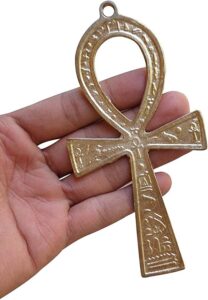Ornaments of Ancient Egypt
 Ornaments of Ancient Egypt: ANKH or the ANSATA cross is the most established talisman of Egypt. Hieroglyphic Ankh sign means life or unceasing life. Regard, to the material world as well as, in a most vital manner to the living past, the second life, the life of the soul.
Ornaments of Ancient Egypt: ANKH or the ANSATA cross is the most established talisman of Egypt. Hieroglyphic Ankh sign means life or unceasing life. Regard, to the material world as well as, in a most vital manner to the living past, the second life, the life of the soul.
The Ankh image joins the generative standards of man and lady in a solitary outline. Circle or twist speaks to the female conceptive organs and what stays manly.
Ornaments of Ancient Egypt
This picture is like the Christian cross; It just changes the upper part, which has an oval ring. The upper ring speaks to the passageway of the water that overflowed the Nile Valley and created ripeness. It was one of the primary characteristics of the goddess Isis, who was who figured out how to convey back life to her significant other and sibling Osiris. Despite the fact that, actually, a large portion of the divine beings, in his ability as undying, wore it.
There are numerous etchings and figures which show up a God or goddess with the cross in his grasp, conveying it to the nose of some other God or ensured. With this signal, the bearer of the cross gives the breath of life to another, who thus, got it through your nostrils. It is frequently spoken to in the hand of the Egyptian pharaohs, whose Coronation assumed an essential part.
Ornaments of Ancient Egypt
It is the existence of capital, which does not end with death, which stirs and proceeds. Thus, connected to the front of the Pharaohs, his vision of endlessness won all through his term over any mishap.
It as an ornament advances lifespan and insight that has lived numerous lives. Convey a charm with the Ankh intends to apply for ripeness and plenitude. Yet additionally above and beyond: go in the quest for a most profound sense of being.
IEB or heart:
The divine beings this fulfilled “(ieb-neteru-hotep).” For the old Egyptians, the heart was simply the place of thought, feeling, and life itself. In the trial before Osiris, the heart was substantial rather than pen the equity and truth (ma’at); presenting the Psychics “gracious, my heart. not stay as an observer against me. I don’t cross under the watchful eye of the judges. Not act against me before the divine beings.
Ornaments of Ancient Egypt
Try not to be my adversary within the sight of the watchman of the adjust Anubis. “, so the ieb ornament was of essential significance for the entry to the following level of presence.” The ieb word shows up on the ideas as a “decent companion” (ak-ieb) interpreted as “one that you entered in the heart”, “satisfaction” (au-ieb), and religious articulations, for example, “the core of the divine beings this satisfied”(ieb-neteru-hotep). Ornaments of Ancient Egypt.
Ornaments of Ancient Egypt
The amuletos-corazon are carnelian, red Jasper, red earthenware or shaded glue. Both carnelian red Jasper symbolizes the dynamism, the bravery to stand up to the undetectable foes. They identify with the rage of the divine beings shielding their places, whose root must be paradise and not the creature’s interests. It is the magnification, little girl of paradise.
The TYET:
The Tyet or Isis hitch is a special necklace that symbolizes the female recovery; its ruddy shading insinuates “the blood of Isis”. Since the lady gives life, their part in Egyptian enchantment was major; being the primary example of the goddess Isis, “Woman of enchantment”. Now and then the tiet likewise exemplifies the Nut goddesses, Hathor and Nephthys, where the bunch is a sort of dress, with the focal part and the side parts shaping an adapted headband.
The Association of the tiet with ladylike and the djed with the manly was an approach to express the double idea of life, and in addition being an emblematic portrayal of the divine beings Isis and Osiris, Horus Dios guardians. The tyet sign is likewise utilized as an emblem of office to Butler or “appointee” Palace (jerepah). Ornaments of Ancient Egypt.
The bunch of the goddess Isis, otherwise called the image of Tyet, was an adapted portrayal of the goddess’s private parts. Relatively every lady wearing this special necklace that will concede the shrewdness of Isis and its information. This ornament fills in as a ripeness engages. It was quite often made of Red stone and contained a green stone. It used to be situated on the throat or chest.
The URAEUS:
The uraeus, or aureus, is a portrayal of the goddess Wadjet. The picture of the uraeus was the favored defensive insignia of numerous Pharaohs, who were the main ones who could convey it as an unmistakable quality of sovereignty. Uraeus was the term utilized Horapolon, an understudy of high Egypt, toward the finish of the fifth-century b.c., in his treatise Hieroglyphica demonstrating an ideographic translation of hieroglyphic composition, and from that point forward the name was kept. Ornaments of Ancient Egypt.
The uraeus had the type of Cobra and, now and again, wore the Red of the lower Egypt Crown and the white of the high Egypt Crown. The goddess cobra Wadjet, used to show up alongside the goddess Nekhbet Vulture, as agents of upper and low Egypt.
Wadjet, beginning in the Nile delta, symbolized the lower Egypt, defensive goddess of the Pharaoh, was a serpent that went about as insurance of divine beings and Pharaohs in the folklore of antiquated Egypt and is credited with the normal for being intense. It encapsulated the sun-oriented goddesses.
Nekhbet, portrayed as a vulture, was an image of high Egypt; this defensive divinity of the Pharaoh in births, the crowning ceremony, Jubilee celebrations, and in the fights.
One of the titles of the Pharaoh, the Nebty name contains the Uraeus. Additionally delineated on the highest point of numerous sanctuaries and part of Egyptian crowns, as headband holding the Nemes (hat of the Pharaohs), and in gems or ornaments of Pharaohs and divine beings. Ornaments of Ancient Egypt.
Cobra and snake were images of revival and were related to the sun-based myths of the voyage of the Sun by the sky and the black market, the Duat. He loved them for the most part in Buto and kicking the bucket they stored in boxes of bronze or wood, engraved with reliefs of pictures of snakes, which now and then had human head touched the twofold Crown with the uraeus.
THE DYED PILLAR:
Pilar Dyed is an image that could speak to the foundation of the God Osiris, a tree, a post made of bound bundles of grain, and so on. It is a standout amongst the most imitated in Egyptian folklore, in spite of the fact that it is obscure the question that really speaks to.
The colored column may be an old fixation from ancient circumstances, related to rural customs, that kept going in Egyptian iconography, being spoken to up to the time of Roman mastery. Ornaments of Ancient Egypt.
Of time Tinita known columns Dyed, found in Helwan. Afterward, amid the Old Kingdom, it was recorded at the entombment site of Pharaoh Djoser (Zoser) at Saqqara, the necropolis of Memphis, and appears to demonstrate that it was an image related with different ideas, for example, support of the sky; Alternatively, he could be allocated to different gods, for example, Sokar and Ptah, as these lords of Memphis are spoken to conveying this image.
Amid the new Kingdom, the Papyrus of Ani, is attracted by the indication of life, Anj, with arms that convey a sunlight based circle rising, went with, on the two sides, his sister Neftis and his significant other Isis, with a few monkeys that salute and love the Sun. Osiris is spoken to with a Dyed shape.
It is conceivable that when Osiris, Ptah, and Sokar were related, the column turned out to be a piece of the imagery of Osiris when his faction spread generally. The Dyed column is additionally situated in spoken to in the utilization of the divine beings Thoth and Khonsu staffs.
“The erection of the Dyed column” was a popular function of the Memphis cause, perhaps to pay tribute to the God Ptah, who was accordingly connected with Osiris. By holding this function has symbolized the dependability of the rule, the restoration of Osiris, and the triumph of this God on Seth.
This service was an approach to recharge, recover and revive the powers of Pharaoh occasionally so he could proceed with the rule on the royal position of Egypt. Also, Heb Sed ought to be rehashed amid the gathering. You can be seen, among different spots, in the Temple of SETI I at Abydos, the place of love to Osiris.
The eye of Horus “the eye that sees it”:
The eye of Horus is a standout amongst the most renowned of the old Egypt charms and the present Muslim world. As charm symbolizes wellbeing, thriving, the indestructibility of the body, and the capacity to be reawakened. The wedjat, a mostly human and somewhat of Hawk-Eye, is the eye of Horus, God of paradise, and comes to signify “unit or completely reestablished”. These ornaments were helpful sickness as well as against selling out, Psychics, and reviles sent by foes and the stink eye.
It was a standout amongst the most effective special necklaces, particularly securing the entry point honed in the Mummy to extricate his organs. Spoken to you to the eye, since for a huge number of years, with a hover with a speck in the Center, a similar image that speaks to the Sun and, hence, speaks to the energy of the unceasing, perpetual after some time.
The bug as an appeal:
The bug was an ornament of life and power, the state of manure bug (Scarabaeus sacer Egyptian), which spoke to the rising sun, and was an image of the restoration in Egyptian folklore. Life gave security from shrewd, unmistakable, or undetectable, giving day by day quality and power. In death, who conveyed it picked up the capacity to revive and interminable life.
The creepy crawly was connected with the God Khepri, the type of Ra as a rising sun, and was the image of the consistent change of the presence.
A few types of creepy crawlies baseball players, particularly the Scarabaeus sacer, delighted in a status that is consecrated to the Egyptians.
Her hieroglyphic name transliterates into as xpr, and interprets as “change over” or “change”. The subordinate term xprw interprets as “frame”, “change”, “occasion”, “method of being” or “the auto-made”, contingent upon the specific circumstance. You can have existential, anecdotal, or ontological importance.
The insect was related with Khepri, the auto-made, the God-related with the rising sun. It was once suspected that the insect was just of male sexual orientation and that it replicated by saving semen into a chunk of waste. The purported self-generation of the creepy-crawly looks like Khepri, which was in like manner made from nothing. Then again, the compost ball moved by the excrement beet
